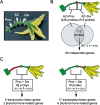Expression profiling of tomato pre-abscission pedicels provides insights into abscission zone properties including competence to respond to abscission signals
- PMID: 23497084
- PMCID: PMC3600680
- DOI: 10.1186/1471-2229-13-40
Expression profiling of tomato pre-abscission pedicels provides insights into abscission zone properties including competence to respond to abscission signals
Abstract
Background: Detachment of plant organs occurs in abscission zones (AZs). During plant growth, the AZ forms, but does not develop further until the cells perceive abscission-promoting signals and initiate detachment. Upon signal perception, abscission initiates immediately; if there is no signal, abscission is not induced and the organ remains attached to the plant. However, little attention has been paid to the genes that maintain competence to respond to the abscission signal in the pre-abscission AZ. Recently, we found that the tomato (Solanum lycopersicum) transcription factors BLIND (Bl), GOBLET (GOB), Lateral suppressor (Ls) and a tomato WUSCHEL homologue (LeWUS) are expressed specifically in pre-abscission tissue, the anthesis pedicel AZs. To advance our understanding of abscission, here we profiled genome-wide gene expression in tomato flower pedicels at the pre-abscission stage.
Results: We examined the transcriptomes of three tomato flower pedicel regions, the AZ and flanking proximal- (Prox) and distal- (Dis) regions, and identified 89 genes that were preferentially expressed in the AZ compared to both Prox and Dis. These genes included several transcription factors that regulate apical or axillary shoot meristem activity. Also, genes associated with auxin activity were regulated in a Prox-Dis region-specific manner, suggesting that a gradient of auxin exists in the pedicel. A MADS-box gene affecting floral transition was preferentially expressed in the Prox region and other MADS-box genes for floral organ identification were preferentially expressed in Dis, implying that the morphologically similar Prox and Dis regions have distinct identities. We also analyzed the expression of known regulators; in anthesis pedicels, Bl, GOB, Ls and LeWUS were expressed in the vascular cells of the AZ region. However, after an abscission signal, Bl was up-regulated, but GOB, Ls and LeWUS were down-regulated, suggesting that Bl may be a positive regulator of abscission, but the others may be negative regulators.
Conclusions: This study reveals region-specific gene expression in tomato flower pedicels at anthesis and identifies factors that may determine the physiological properties of the pre-abscission pedicel. The region-specific transcriptional regulators and genes for auxin activity identified here may prevent flower abscission in the absence of signal or establish competence to respond to the abscission signal.
Figures


References
-
- Addicot FT. Abscission. Berkeley, CA: University of California Press; 1982.
-
- van Nocker S. Development of the abscission zone. Stewart Postharvest Review. 2009;5(1):5.
Publication types
MeSH terms
Substances
LinkOut - more resources
Full Text Sources
Other Literature Sources
Molecular Biology Databases

